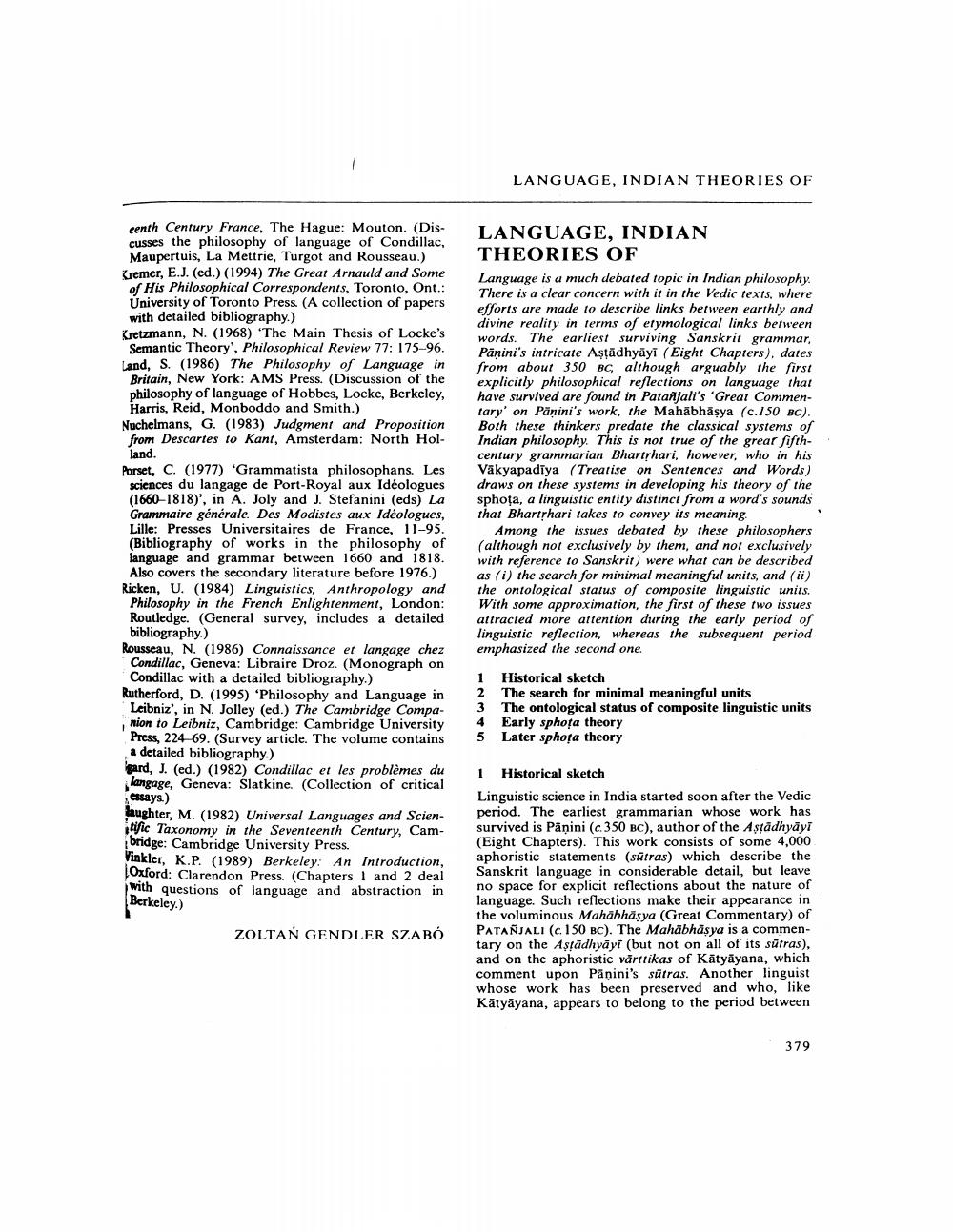Book Title: Language Indian Theories Of Author(s): Johannes Bronkhorst Publisher: Johannes Bronkhorst View full book textPage 1
________________ LANGUAGE, INDIAN THEORIES OF eenth Century France, The Hague: Mouton. (Discusses the philosophy of language of Condillac, Maupertuis, La Mettrie, Turgot and Rousseau.) Cremer, E.J. (ed.) (1994) The Great Arnauld and Some of His Philosophical Correspondents, Toronto, Ont.: University of Toronto Press. (A collection of papers with detailed bibliography.) Kretzmann, N. (1968) 'The Main Thesis of Locke's Semantic Theory', Philosophical Review 77: 175-96. Land, S. (1986) The Philosophy of Language in Britain, New York: AMS Press. (Discussion of the philosophy of language of Hobbes, Locke, Berkeley, Harris, Reid, Monboddo and Smith.) Nuchelmans, G. (1983) Judgment and Proposition from Descartes to Kant, Amsterdam: North Holland. Porset, C. (1977) 'Grammatista philosophans. Les sciences du langage de Port-Royal aux Idéologues (1660-1818)', in A. Joly and J. Stefanini (eds) La Grammaire générale. Des Modistes aux Idéologues, Lille: Presses Universitaires de France, 11-95. (Bibliography of works in the philosophy of language and grammar between 1660 and 1818. Also covers the secondary literature before 1976.) Ricken, U. (1984) Linguistics, Anthropology and Philosophy in the French Enlightenment, London: Routledge. (General survey, includes a detailed bibliography.) Rousseau, N. (1986) Connaissance et langage chez Condillac, Geneva: Libraire Droz. (Monograph on Condillac with a detailed bibliography.) Rutherford, D. (1995) 'Philosophy and Language in Leibniz', in N. Jolley (ed.) The Cambridge Companion to Leibniz, Cambridge: Cambridge University Press, 224 69. (Survey article. The volume contains a detailed bibliography.) gard, J. (ed.) (1982) Condillac et les problèmes du Langage, Geneva: Slatkine. (Collection of critical LANGUAGE, INDIAN THEORIES OF Language is a much debated topic in Indian philosophy There is a clear concern with it in the Vedic texts, where efforts are made to describe links between earthly and divine reality in terms of etymological links between words. The earliest surviving Sanskrit grammar, Panini's intricate Aştādhyāyi (Eight Chapters), dates from about 350 BC, although arguably the first explicitly philosophical reflections on language that have survived are found in Patanjali's 'Great Commentary' on Panini's work, the Mahābhāşya (c.150 BC). Both these thinkers predate the classical systems of Indian philosophy. This is not true of the grear fifthcentury grammarian Bhartrhari, however, who in his Väkyapadīya (Treatise on Sentences and Words) draws on these systems in developing his theory of the sphota, a linguistic entity distinct from a word's sounds that Bhartrhari takes to convey its meaning Among the issues debated by these philosophers (although not exclusively by them, and not exclusively with reference to Sanskrit) were what can be described as (i) the search for minimal meaningful units, and (ii) the ontological status of composite linguistic units. With some approximation, the first of these two issues attracted more attention during the early period of linguistic reflection, whereas the subsequent period emphasized the second one. 1 2 3 4 5 Historical sketch The search for minimal meaningful units The ontological status of composite linguistic units Early sphota theory Later sphoța theory essays.) aughter, M. (1982) Universal Languages and Scien fic Taxonomy in the Seventeenth Century, Cambridge: Cambridge University Press. Vinkler, K.P. (1989) Berkeley: An Introduction, LOxford: Clarendon Press. (Chapters 1 and 2 deal with questions of language and abstraction in Berkeley.) 1 Historical sketch Linguistic science in India started soon after the Vedic period. The earliest grammarian whose work has survived is Pāņini (c.350 BC), author of the Astādhyāyī (Eight Chapters). This work consists of some 4,000 aphoristic statements (sūtras) which describe the Sanskrit language in considerable detail, but leave no space for explicit reflections about the nature of language. Such reflections make their appearance in the voluminous Mahābhāsya (Great Commentary) of PATANJALI (c.150 BC). The Mahābhāsya is a commentary on the Asfadhyāyi (but not on all of its sūtras), and on the aphoristic vārtikas of Kätyāyana, which comment upon Pāņini's sūtras. Another linguist whose work has been preserved and who, like Kātyāyana, appears to belong to the period between ZOLTAN GENDLER SZABÓ 379Page Navigation
1 2 3 4 5 6
